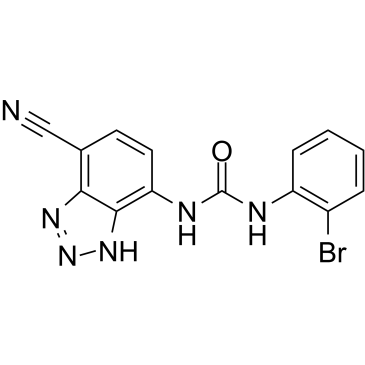SB 265610

SB 265610 structure
|
Common Name | SB 265610 | ||
|---|---|---|---|---|
| CAS Number | 211096-49-0 | Molecular Weight | 357.16500 | |
| Density | 1.779 g/cm3 | Boiling Point | 527ºC at 760 mmHg | |
| Molecular Formula | C14H9BrN6O | Melting Point | N/A | |
| MSDS | Chinese USA | Flash Point | 272.5ºC | |
| Symbol |

GHS07 |
Signal Word | Warning | |
Use of SB 265610SB-265610 is a selective, competitive, nonpeptide and allosteric CXCR2 antagonist. SB-265610 blocks rat cytokine-induced neutrophil chemoattractant-1 (CINC-1)-induced calcium mobilization and neutrophil chemotaxis with IC50s of 3.7 nM and 70 nM, respectively[1][2]. |
| Name | 1-(2-bromophenyl)-3-(7-cyano-2H-benzotriazol-4-yl)urea |
|---|---|
| Synonym | More Synonyms |
| Description | SB-265610 is a selective, competitive, nonpeptide and allosteric CXCR2 antagonist. SB-265610 blocks rat cytokine-induced neutrophil chemoattractant-1 (CINC-1)-induced calcium mobilization and neutrophil chemotaxis with IC50s of 3.7 nM and 70 nM, respectively[1][2]. |
|---|---|
| Related Catalog | |
| Target |
CXCR2 |
| In Vitro | In vitro, SB-265610 antagonizes rat cytokine-induced neutrophil chemoattractant-1 (CINC-1)-induced calcium mobilization, IC50 of 3.7 nM, and rat neutrophil chemotaxis in a concentration-dependent manner, IC50 of 70 nM. SB-265610 reduces the antiapoptotic effect of CINC-1 to the levels of those untreated with CINC-1[1]. |
| In Vivo | SB-265610 (100 mg/kg/day; oral administration; daily; for 5 days; CXCR2 wild type mice) treatment during the wound repair process markedly delays healing parameters in CXCR2 wild type mice[2]. Animal Model: Wild type mice with nitrogen mustard[2] Dosage: 100 mg/kg/day Administration: Oral administration; daily; for 5 days Result: Markedly impaired the wound healing process. |
| References |
| Density | 1.779 g/cm3 |
|---|---|
| Boiling Point | 527ºC at 760 mmHg |
| Molecular Formula | C14H9BrN6O |
| Molecular Weight | 357.16500 |
| Flash Point | 272.5ºC |
| Exact Mass | 356.00200 |
| PSA | 106.49000 |
| LogP | 3.38208 |
|
Regulation of CXCR2 expression and function by a disintegrin and metalloprotease-17 (ADAM17).
J. Leukoc. Biol. 97(3) , 447-54, (2015) The chemokine receptor CXCR2 is expressed at high levels on circulating neutrophils and is critical for directing their migration to sites of inflammation. CXCR2 surface levels are rapidly modulated b... |
|
|
Discovery of Novel CXCR2 Inhibitors Using Ligand-Based Pharmacophore Models.
J. Chem. Inf. Model. 55 , 1720-38, (2015) The chemokine receptor CXCR2 is expressed on various immune cells and is essential for neutrophil recruitment and angiogenesis at sites of acute and chronic inflammation caused by tissue injury or inf... |
|
|
Mesenchymal transition and dissemination of cancer cells is driven by myeloid-derived suppressor cells infiltrating the primary tumor.
PLoS Biol. 9 , e1001162, (2011) In order to metastasize, cancer cells need to acquire a motile phenotype. Previously, development of this phenotype was thought to rely on the acquisition of selected, random mutations and thus would ... |
| SB 265610 |